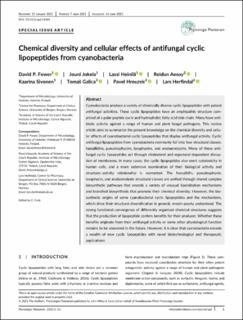| dc.description.abstract | Cyanobacteria produce a variety of chemically diverse cyclic lipopeptides with potent antifungal activities. These cyclic lipopeptides have an amphipathic structure comprised of a polar peptide cycle and hydrophobic fatty acid side chain. Many have antibiotic activity against a range of human and plant fungal pathogens. This review article aims to summarize the present knowledge on the chemical diversity and cellular effects of cyanobacterial cyclic lipopeptides that display antifungal activity. Cyclic antifungal lipopeptides from cyanobacteria commonly fall into four structural classes; hassallidins, puwainaphycins, laxaphycins, and anabaenolysins. Many of these antifungal cyclic lipopeptides act through cholesterol and ergosterol-dependent disruption of membranes. In many cases, the cyclic lipopeptides also exert cytotoxicity in human cells, and a more extensive examination of their biological activity and structure–activity relationship is warranted. The hassallidin, puwainaphycin, laxaphycin, and anabaenolysin structural classes are unified through shared complex biosynthetic pathways that encode a variety of unusual lipoinitiation mechanisms and branched biosynthesis that promote their chemical diversity. However, the biosynthetic origins of some cyanobacterial cyclic lipopeptides and the mechanisms, which drive their structural diversification in general, remain poorly understood. The strong functional convergence of differently organized chemical structures suggests that the production of lipopeptide confers benefits for their producer. Whether these benefits originate from their antifungal activity or some other physiological function remains to be answered in the future. However, it is clear that cyanobacteria encode a wealth of new cyclic lipopeptides with novel biotechnological and therapeutic applications. | en_US |

